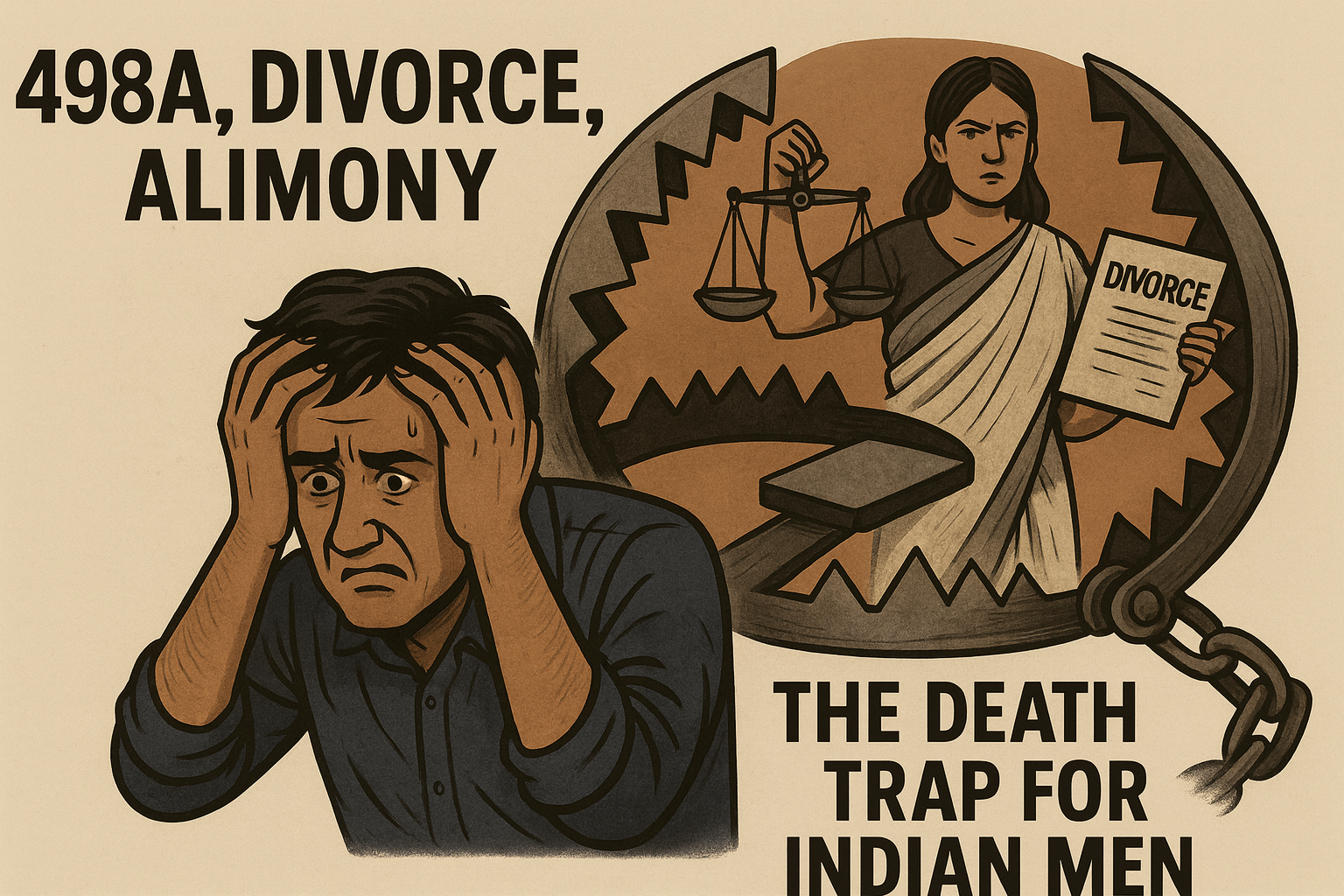Section 498A of the Indian Penal Code (IPC) has been replaced by Section 85 of the Bharatiya Nyaya Sanhita (BNS) (2023)
498A, Divorce, Alimony – The death trap for Indian Men
Alimony and protective criminal provisions such as Section 498A of the Indian Penal Code were created to protect vulnerable spouses — mostly wives in traditional socio-economic setups — from destitution or violent domestic control. Those aims are legitimate and necessary. But any legal tool that transfers coercive power to one party without careful safeguards will be gamed by a minority. Over the last few years Indian courts, journalists and researchers have repeatedly flagged instances where divorce proceedings, criminal FIRs and sky-high alimony claims have been used as instruments of pressure, extortion and tactical leverage — sometimes by spouses, sometimes by outside actors — rather than as remedies for genuine injustice. The damage is threefold: innocent persons are publicly shamed and jailed, family members (including elderly parents) are dragged into criminal probes, and public confidence in protective laws erodes — which hurts real victims.
Suicide of Atul Subhash
Atul Subhash (1990 – 9 December 2024) was a Bengaluru-based software engineer and AI professional who died by suicide at his apartment in Marathahalli. His death drew national attention to alleged misuse of India’s matrimonial and dowry laws, judicial corruption, and the mental toll of prolonged divorce battles.
Originally from Bihar, Atul had been embroiled in a contentious divorce and custody dispute with his estranged wife, Nikita Singhania, whom he married in 2019. The couple had a four-year-old son and had lived separately for three years. In his 24-page note and 81-minute video, Atul detailed alleged harassment, extortion, and biased court proceedings, claiming his in-laws demanded Rs 3 crore for settlement and denied him access to his child.
Atul accused Jaunpur District Court Judge Reeta Kaushik of soliciting a Rs 5 lakh bribe and allegedly provoking him when he refused. His suicide note, titled “This ATM has been closed permanently,” became symbolic among men’s rights activists highlighting the misuse of Section 498A IPC (dowry harassment law) and systemic bias in family courts.
Following his death, public outrage and protests spread online under men’s rights groups such as the Save Indian Family Foundation. A police case was filed charging Singhania and her relatives with abetment to suicide (Section 309 IPC); they were later granted bail.
Atul’s death also brought renewed attention to similar suicides allegedly linked to judicial and legal harassment, including those of Suresh Sathadiya, Nitin Padiyar, and Puneet Khurana, fueling debate over reforming India’s family and dowry laws to prevent further misuse.
Gujarat Man’s Suicide Sparks Case Against Wife
Suresh Sathadiya (39), a resident of Zamrala village in Botad district, Gujarat, died by suicide on December 30. He left behind a video message asking his family to “teach her a lesson” for allegedly causing his death.
Following a complaint from Sathadiya’s father, police registered a case against his wife under Section 108 (abetment of suicide) of the Bharatiya Nyay Sanhita.
According to the complaint, Sathadiya faced mental harassment and frequent quarrels from his wife, who often left for her parents’ home. On the day of his death, he had reportedly gone to her house to reconcile, but when she refused to return, he came back home and took his life. The Botad rural police have begun an investigation into the incident.
Indore Man’s Suicide Highlights Misuse of Marital Laws, Calls for Reform
Nitin Padiyar (28) from Indore, Madhya Pradesh, died by suicide on January 22, 2025, allegedly due to harassment from his estranged wife and her family.
In his suicide note, Padiyar accused them of mental cruelty and urged the government to amend marital laws, stating that “women are misusing the law; many boys and their families will continue to be ruined.” He also left a heartfelt message for his mother, asking her not to cry and expressing continued pain even after death if she grieved.
The case has reignited public debate on gender bias in matrimonial laws, mental health awareness for men, and the need for legal reforms to prevent misuse of protective provisions.
Businessman Puneet Khurana Dies by Suicide After Alleged Harassment Over Extra Settlement
Puneet Khurana (40), a businessman from Model Town, died by suicide after allegedly facing pressure from his wife and in-laws for an additional ₹10 lakh beyond an already agreed-upon divorce settlement.
In a 59-minute video recorded before his death, Puneet said he had already signed a mutual divorce agreement with certain terms and conditions under the court’s 180-day period. However, just 90 days into the process, his wife and in-laws allegedly demanded new terms and additional money he could not afford.
He stated he could not ask his parents for more funds as they had “already suffered enough.” Puneet claimed he was “extremely tortured” by his wife and in-laws, calling the video his final statement explaining the circumstances that led him to take his own life.
Man Opens “#498A Tea Café” to Protest False Dowry Case – Click Here
A man from Madhya Pradesh set up a “#498A Tea Café” stall near his in-laws’ house in Rajasthan to protest alleged false domestic violence and dowry charges filed by his wife under Sections 498A IPC and 125 CrPC.
After facing severe emotional and financial distress since his wife left in 2022, he inaugurated the stall wearing handcuffs — symbolizing how men are “chained” by misuse of dowry and domestic violence laws.
The unique protest has drawn public attention to growing concerns over legal misuse and men’s rights awareness in India.
6 Husband Case – Click Here
6 ଟା ସ୍ବାମୀ କେସ୍ – A famous case in Karnataka where a Woman Lawyer married 7 times, divorced 6 husbands for Alimony. Mockery & misuse of law+ Shame on Judiciary
Auto Driver’s Plight Exposes the “Business” of Divorce and Alimony – Click Here
An auto driver reportedly took a Rs 2 lakh loan to pay alimony after his marriage, which lasted just three months. His wife had demanded a Rs 20 lakh settlement, sparking outrage over the growing trend of financial exploitation through quick divorces.
Observers have dubbed it “The Business of Marriage-Divorce-Alimony,” where some treat marriage like a startup — begin it, file for divorce within weeks or months, claim a large, tax-free alimony payout, and move on.
The case underscores the urgent need for legal scrutiny and reform in India’s matrimonial and alimony systems to prevent misuse and protect individuals from financial ruin.
SHOCKING STUDY ON DIVORCE IN INDIA (Finance Magazine)
💔 42% of Indian men were forced to take loans to pay divorce settlements or alimony
💰 67% of divorces originated primarily from financial disputes between couples
⚖️ 26% of women reportedly walked away with 100% of their husband’s net worth as part of alimony settlements – Click Here
What’s happening on the ground (and in the courts)
- Extravagant alimony demands used as leverage
A high-profile Supreme Court matter drew attention when a wife sought astronomical permanent alimony (reported demand: Rs 500 crore) and the Court, while awarding far less (Rs 12 crore), warned about the weaponization of criminal complaints to pressure settlements and the improper use of police machinery in matrimonial disputes. The judgment and accompanying commentary signal judicial discomfort with turning criminal law into a bargaining chip. - Courts quashing FIRs filed to force divorce/settlement
The Supreme Court quashed criminal proceedings under Section 498A after concluding the FIR had been filed with an “ulterior motive” — essentially to force the husband to consent to divorce — highlighting that some complaints are tactical rather than truthful. The Court explicitly warned against vague, generalized allegations that amount to arm-twisting. - Arrests at airports, elderly relatives dragged into cases
Reporting around the Rs 12-crore matter revealed dramatic facts: arrests made on Look-Out Circulars at airports, and FIRs naming elderly parents — practices courts have said should be scrutinized carefully because they can be punitive rather than investigatory. The imagery of a man detained at an airport because of matrimonial litigation crystallizes how criminal process can be used as leverage. - High courts publicly reprimanding complainants
Courts — including recent judgments from High Courts — have rebuked wives who pursued long, detail-free criminal complaints under Sections 498A/406/34 and dismissed cases as frivolous, noting the emotional and material toll on the accused families. These judicial rebukes reinforce that misuse is not merely an internet talking point but an issue recognized by judges. - Quash orders in lower courts for implausible cruelty claims
Several High Court orders in 2024–2025 have quashed cruelty/Dowry-related FIRs where fact-finding suggested the criminal complaints were being used to gain negotiating advantage in matrimonial settlements. These are increasingly frequent in legal reporting and analyses. - Media and surveys documenting financial strain on men
Independent surveys and reporting show many men take loans to satisfy alimony/settlement demands; divorce is increasingly expensive and weaponized in urban India, raising questions about incentives and remedies for genuine victims on both sides. The economics of divorce matter — when the threat of criminal action can force quick settlements, the pressure to capitulate is real. - Judicial guidance (Rajnesh v. Neha and after)
The Supreme Court’s framework in Rajnesh v. Neha (and subsequent restatements) lays down factors to determine interim and permanent maintenance — showing courts’ attempts to reduce arbitrariness. Those decisions are referenced regularly in recent rulings that push back against unreasonable claims. They show the judiciary is aware of the problem and trying to systematize fairer outcomes. - Quashing where complainant’s motive contradicts facts
Multiple judgments have pointed out that when a complaint’s facts are inconsistent with contemporaneous records (e.g., family reconciliations, simultaneous negotiations for property), the probability that an FIR was lodged for leverage increases; judges have quashed such FIRs citing misuse. (See multiple December 2024 rulings summarized by legal reporting services.) - High court decisions protecting non-relatives (and matchmakers) from 498A stretch
Courts have quashed or refused to entertain 498A complaints where the accused was not a “relative” within the statutory meaning or where allegations did not disclose active involvement — a legal constraint sometimes flouted in FIRs filed for pressure. Recent Bombay High Court rulings illustrate this corrective trend. - Public debate and institutional worry
Legal commentators, judges and civil-society actors have publicly warned that misuse of 498A and opportunistic alimony demands are undermining both justice and genuine victims’ protection — a debate that’s now reflected in jurisprudence and media reporting.
(These ten items combine reported cases, major judgments and judicial commentary to illustrate the recurring patterns courts identify. Where specific party names are in the record I’ve cited the original judgments/reports; where a name like “Atul Subhas” couldn’t be found in public reporting I did not invent details.)
Who’s responsible — and who’s being blamed?
It is tempting to point fingers at “women,” “lawyers,” or “the judiciary.” That’s simplistic and dangerous. The reality is structural:
- A small subset of litigants (of any gender) and their advisors have discovered that criminal complaints and aggressive civil claims can coerce rapid settlements.
- Some lawyers exploit this dynamic; courtroom and police leverage accelerate outcomes (some of which are unjust). That’s professional misconduct when it occurs.
- The police and early-stage processes are problematic: automatic registration of FIRs, quick arrests on the basis of one-sided complaints, and media exposure create leverage disproportionate to the underlying allegations.
- Judges sometimes respond belatedly, but the judiciary is also actively pushing back — quashing FIRs, clarifying law on alimony, and laying down guidelines — because they see the harm. Cases of allegations of corruption as we have seen in the famuous Athul Subhas case
So while abuse exists, so does judicial correction, and both realities must be named.
Policy fixes and practical safeguards
If the goal is to protect genuine victims while preventing weaponisation, reforms should include:
- Early, independent fact-finding before arrest in matrimonial FIRs that lack specific allegations — i.e., a screening mechanism.
- Mandatory asset disclosure and mediation before extravagant permanent alimony claims are entertained in full fanfare.
- Sanctions against frivolous complaints and abusive lawyers (costs, professional discipline) to deter strategic FIRs.
- Faster summary procedures for quashing manifestly malicious FIRs, with interim protection for accused families.
- Public legal education: clarify that protective laws exist for abuse victims — not for enrichment or retaliation.
Criticism tempered by evidence
There is a genuine problem when legal instruments intended as shields become swords in the hands of a few. The answer is not to delegitimise protection for abuse victims — far from it — but to insist on due process, objective fact-finding, and professional ethics. Courts have already begun to call out misuse and are issuing guidelines; policymakers and law-enforcement have to close the gap between those judicial signals and everyday policing and practice.
A short film on Alimony – Click Here
Frequently Asked Questions (FAQs): Divorce, Alimony, and Men’s Rights in India
1. Why are so many men reportedly taking extreme steps during divorce or 498A cases?
Many men cite a mix of financial pressure, prolonged legal battles, restricted access to their children, and social stigma. When settlements or maintenance demands exceed their means, and the justice process feels one-sided, some experience hopelessness that leads to tragic outcomes.
➡️ Mental health support and timely legal intervention are critical to prevent such crises.
2. What is Section 498A of the Indian Penal Code?
Section 498A is a criminal law enacted in 1983 to protect women from cruelty or dowry harassment by husbands or their relatives. It is non-bailable and cognizable, meaning police can arrest without a warrant.
While its intent is protective, courts and commissions have acknowledged instances of misuse, where false or exaggerated cases are filed to pressure the husband or extract settlements.
3. What legal safeguards exist against false 498A cases?
The judiciary has introduced several checks:
- Arnesh Kumar vs. State of Bihar (2014) – Police must verify allegations before arrest.
- Family Welfare Committees (FWCs) – Some states use neutral mediators to examine complaints before FIR registration.
- Quashing powers under CrPC Section 482 – High Courts can dismiss manifestly malicious cases.
4. What can men do if they are falsely accused under 498A or similar laws?
- Stay calm and hire a competent family-law lawyer experienced in men’s rights cases.
- Collect all documentation, chats, and witnesses proving innocence.
- Apply for anticipatory bail immediately.
- File counter-cases (defamation, extortion, perjury) if evidence of falsehood exists.
- Avoid public confrontation or threats, which can worsen legal exposure.
5. How does alimony work in India?
Alimony (maintenance) can be ordered:
- During proceedings – “interim maintenance.”
- After divorce – “permanent alimony.”
Courts decide the amount based on income, lifestyle, dependents, and length of marriage. There is no fixed percentage, and both genders can technically seek alimony, though men rarely do.
6. Can a husband also claim alimony or maintenance?
Yes. If the husband is economically weaker or disabled, he may claim maintenance under Section 24 of the Hindu Marriage Act, 1955 or equivalent laws. Courts are gradually recognizing this, though societal taboos make it rare.
7. What should families do when facing emotional breakdowns in such disputes?
- Seek counselling or therapy early, ideally from neutral mental-health professionals.
- Avoid isolation; connect with trusted friends or men’s support groups like Save Indian Family Foundation or SIFF Helpline.
- Never ignore suicidal talk or depression — reach out to helplines like:
- 📞 AASRA: 91-9820466726
- 📞 Snehi: 91-9582208181
- 📞 NIMHANS Helpline: 080-46110007
8. Are there movements demanding reforms in marriage and divorce laws?
Yes. Several civil-society groups advocate for:
- Gender-neutral domestic-violence laws.
- Shared parenting and equal custody rights.
- Penalties for false cases and time-bound case disposal.
These movements push for balanced laws that protect both genuine victims and wrongly accused individuals.
9. How can India balance women’s protection with men’s rights?
The key lies in due process, accountability, and equal empathy:
- Protect women from genuine abuse.
- Ensure men aren’t punished without proof.
- Train police and judges to handle matrimonial disputes as civil conflicts first, not instant criminal cases.
Balance, not bias, must define modern justice.
10. What message do the recent cases of Atul Subhash, Suresh Sathadiya, Nitin Padiyar, and Puneet Khurana send?
They expose the human cost of legal imbalance, social stigma, and slow justice. Each of these men cried for fairness, not exemption. Their stories urge policymakers to reform laws, speed up hearings, and provide mental-health support — so no one feels that death is the only escape from a broken system.
When laws are only for Women and some of them misuses them!
Have you ever faced false dowry or domestic violence allegations that destroyed your peace, career, or family?
ଆପଣ କେବେ ଭୁଲ ଦାହାଜୋଗ ଅଭିଯୋଗ କିମ୍ବା ଘରୋଇ ହିଂସା ମାମଲାରେ ଜୀବନ ଓ ପରିବାର ହାରାଇଛନ୍ତି କି?
Do you know how Section 498A of the IPC — meant to protect women — is now being misused to trap innocent men?
ଆପଣ ଜାଣିଛନ୍ତି କି ମହିଳାଙ୍କ ସୁରକ୍ଷା ପାଇଁ ନିୟମ 498A ବର୍ତ୍ତମାନ ନିର୍ଦୋଷ ପୁରୁଷମାନଙ୍କୁ ଫସାଇବା ପାଇଁ ବ୍ୟବହୃତ ହେଉଛି?
How long will honest men continue to suffer false 498A cases, endless court dates, and mental harassment?
କେତେ ଦିନ ପର୍ଯ୍ୟନ୍ତ ସତ ପୁରୁଷମାନେ ଭୁଲ 498A ମାମଲା, ଅସେଷ କୋର୍ଟ ତାରିଖ ଓ ମାନସିକ ନିର୍ଜାତନା ସହିବେ?
Why are there no laws to protect men from false accusations, blackmail, and legal extortion?
ଭୁଲ ଅଭିଯୋଗ, ଧମକ ଓ ଆଇନୀ ଦୁର୍ବ୍ୟବହାରରୁ ପୁରୁଷମାନଙ୍କୁ ସୁରକ୍ଷା ପାଇଁ କାହିଁକି କୌଣସି ନିୟମ ନାହିଁ?
How many more men like Atul Subhash, Suresh Sathadiya, Nitin Padiyar, and Puneet Khurana must die before society listens?
ଅତୁଲ ସୁଭାଷ, ସୁରେଶ ସଥାଦିୟା, ନିତିନ ପଡିୟାର ଓ ପୁନିତ ଖୁରାନା ଭଳି ଆଉ କେତେ ପୁରୁଷ ମରିବେ, ସମାଜ ସୁନିବା ପୂର୍ବରୁ?
Have you or someone you know been forced to pay heavy alimony or dowry-like settlements to end a false case?
ଆପଣ କିମ୍ବା ଆପଣଙ୍କ ଜଣେ ପରିଚିତ ଭୁଲ ମାମଲା ସେଟଲ କରିବା ପାଇଁ ବହୁତ ଟଙ୍କା ଅଲିମୋନି କିମ୍ବା ଦାହାଜୋଗ ଦେବାକୁ ବାଧ୍ୟ ହୋଇଥିଲେ କି?
Do you believe men deserve equal rights, legal protection, and mental health support during marital disputes?
ଆପଣ ବିଶ୍ୱାସ କରନ୍ତି କି ବିବାହ ସଂପର୍କୀୟ ବିବାଦ ସମୟରେ ପୁରୁଷମାନେ ସମାନ ଅଧିକାର, ଆଇନୀ ସୁରକ୍ଷା ଓ ମାନସିକ ସହାୟତା ପାଇବା ଯୋଗ୍ୟ?
When will India create gender-neutral laws that protect both men and women equally?
ଭାରତ କେବେ ଏମିତି ଲିଙ୍ଗ-ନିରପେକ୍ଷ ନିୟମ ତିଆରି କରିବ, ଯେଉଁଠାରେ ପୁରୁଷ ଓ ମହିଳା ଦୁହେଁ ସମାନ ଭାବେ ସୁରକ୍ଷିତ ହ
Are you one of the many men silenced by fear, stigma, or financial ruin caused by false allegations?
ଆପଣ ସେହି ହଜାର ପୁରୁଷମାନଙ୍କ ମଧ୍ୟରୁ ଜଣେ କି, ଯେଉଁମାନେ ଭୟ, ଅପମାନ ଓ ଆର୍ଥିକ ଧ୍ୱଂସ ଦ୍ୱାରା ଚୁପ୍ ରହିବାକୁ ବାଧ୍ୟ ହୋଇଛନ୍ତି?
If you have faced false cases, harassment, or legal misuse — share your story and find support on our blog. Together, we can demand justice and reform.
ଯଦି ଆପଣ ଭୁଲ ମାମଲା, ନିର୍ଜାତନା କିମ୍ବା ଆଇନୀ ଅତ୍ୟାଚାରର ଶିକାର — ଆପଣଙ୍କ କଥା ଆମ ବ୍ଲଗରେ ଶେୟର କରନ୍ତୁ। ଆମେ ସମେତିକେ ନ୍ୟାୟ ଓ ପରିବର୍ତ୍ତନ ଦାବି କରିପାରିବୁ।




